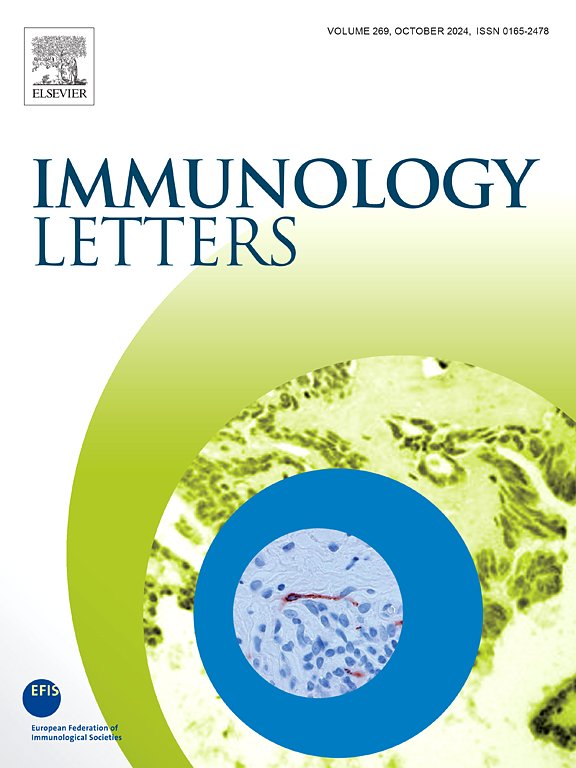Inhibition of FOSL1 alleviates inflammatory injury of otitis media by reducing ferroptosis
IF 2.8
4区 医学
Q3 IMMUNOLOGY
引用次数: 0
Abstract
Objectives
Otitis media (OM) is a disease involving inflammation and infection of the middle ear that primarily affects children. Fos-like antigen 1 (FOSL1), a component of AP1 transcription factor complexes, is a key regulator in inflammation and various diseases. However, the role of FOSL1 in OM remains largely unknown. Our study aimed to elucidate the function and mechanism of FOSL1 in OM.
Methods
The gene expression dataset was obtained from Gene Expression Omnibus (GEO), and the differentially expressed genes (DEGs) from OM mice and control mice were identified. Gene Ontology (GO) and Kyoto Encyclopedia of Genes and Genomes (KEGG) analyzes were used to identify potential biological pathways. Gene set variation analysis (GSVA) and gene set enrichment analysis (GSEA) were performed to excavate the biological signaling pathways. The OM cell model was induced by Staphylococcus aureus and Bacillus cereus administration. The expression of FOSL1 and ferroptosis-related proteins in OM cell model were determined by western blot. Inflammatory cytokines in cells were detected by qPCR.
Results
DEGs was identified from gene set enrichment (GSE) 49128, 441 genes were up-regulated and 180 were down-regulated. FOSL1 was highly expressed in OM mice. Consistent with the bioinformatic analysis, the expression of FOSL1 in bacterial-induced OM cells was upregulated. Inhibition of FOSL1 via siRNA alleviated the inflammatory response and cell ferroptosis in the OM cell model. The reduced level of inflammatory cytokines and cell ferroptosis induced by FOSL1 inhibition could be rescued by ferroptosis activator erastin.
Conclusion
FOSL1 inhibition could alleviate release of inflammatory cytokines and ferroptosis in the OM cell model.
抑制FOSL1可通过减轻铁下垂减轻中耳炎的炎症损伤。
目的:中耳炎(OM)是一种主要影响儿童的中耳炎症和感染疾病。fos样抗原1 (FOSL1)是AP1转录因子复合物的一个组成部分,是炎症和多种疾病的关键调节因子。然而,FOSL1在OM中的作用在很大程度上仍然未知。本研究旨在阐明FOSL1在OM中的作用及其机制。方法:从gene expression Omnibus (GEO)获取基因表达数据集,鉴定OM小鼠和对照小鼠的差异表达基因(DEGs)。使用基因本体(GO)和京都基因与基因组百科全书(KEGG)分析来识别潜在的生物学途径。通过基因集变异分析(GSVA)和基因集富集分析(GSEA)挖掘生物信号通路。采用金黄色葡萄球菌和蜡样芽孢杆菌联合诱导OM细胞模型。western blot检测OM细胞模型中FOSL1及凋亡相关蛋白的表达。采用qPCR检测细胞内炎症因子。结果:从基因集富集(GSE)中共鉴定出DEGs 49128个,其中上调441个,下调180个。FOSL1在OM小鼠中高表达。与生物信息学分析一致,FOSL1在细菌诱导的OM细胞中表达上调。在OM细胞模型中,通过siRNA抑制FOSL1可减轻炎症反应和细胞铁下垂。FOSL1抑制引起的炎症细胞因子水平降低和细胞凋亡可通过铁凋亡激活剂erastin恢复。结论:抑制FOSL1可减轻OM细胞模型炎症因子的释放和铁下垂。
本文章由计算机程序翻译,如有差异,请以英文原文为准。
求助全文
约1分钟内获得全文
求助全文
来源期刊

Immunology letters
医学-免疫学
CiteScore
7.60
自引率
0.00%
发文量
86
审稿时长
44 days
期刊介绍:
Immunology Letters provides a vehicle for the speedy publication of experimental papers, (mini)Reviews and Letters to the Editor addressing all aspects of molecular and cellular immunology. The essential criteria for publication will be clarity, experimental soundness and novelty. Results contradictory to current accepted thinking or ideas divergent from actual dogmas will be considered for publication provided that they are based on solid experimental findings.
Preference will be given to papers of immediate importance to other investigators, either by their experimental data, new ideas or new methodology. Scientific correspondence to the Editor-in-Chief related to the published papers may also be accepted provided that they are short and scientifically relevant to the papers mentioned, in order to provide a continuing forum for discussion.
 求助内容:
求助内容: 应助结果提醒方式:
应助结果提醒方式:


